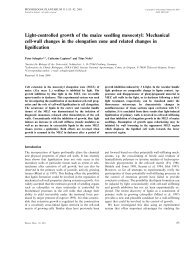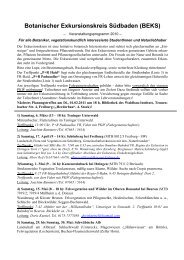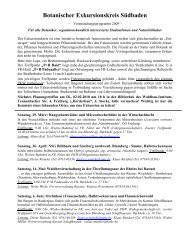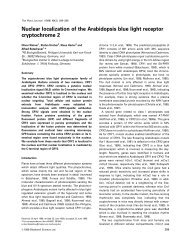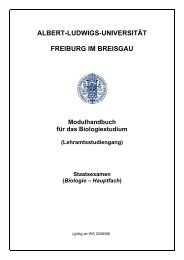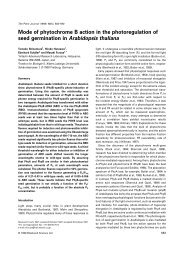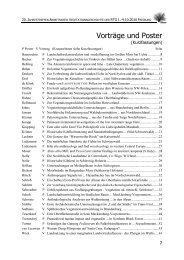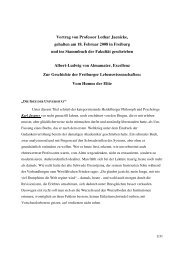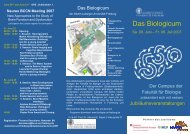SEXUAL SIZE DIMORPHISM AND MORPHOLOGICAL EVIDENCE ...
SEXUAL SIZE DIMORPHISM AND MORPHOLOGICAL EVIDENCE ...
SEXUAL SIZE DIMORPHISM AND MORPHOLOGICAL EVIDENCE ...
Create successful ePaper yourself
Turn your PDF publications into a flip-book with our unique Google optimized e-Paper software.
136 DIEGO SANTIAGO-ALARCON <strong>AND</strong> PATRICIA G. PARKER<br />
TABLE 1. Principal component (PC) scores and<br />
proportion of variance extracted (communalities)<br />
from each variable for the analysis of morphological<br />
differences between male and female Galápagos<br />
Doves. PC scores represent the correlation of each<br />
variable with the principal component and<br />
communalities are the sums of squares of the<br />
correlation coefficients on the first two components<br />
or the proportion of variance extracted from each<br />
variable.<br />
Variable PC1 PC2 Communalities<br />
Culmen 0.88 0.19 0.81<br />
Bill width 0.75 0.48 0.79<br />
Tarsus 0.89 0.18 0.84<br />
Tail 0.82 20.44 0.87<br />
Wing chord 0.93 20.02 0.87<br />
Mass 0.85 20.37 0.86<br />
dimorphism among islands. Wing chord and<br />
tarsus proved to be the two variables that best<br />
predicted body size according to the principal<br />
component analysis (high PC score and high<br />
extracted variance). Additionally, they were the<br />
variables that most reduced Wilk’s lambda<br />
during discriminant analyses (DA). To increase<br />
sample sizes among islands for the calculation<br />
of the sexual size dimorphism index we used the<br />
PopTools 2.5.4 (Hood 2003) add-in for Microsoft<br />
Excel to generate 100 randomizations for<br />
each population before the index was calculated.<br />
We took all individual measurements made<br />
on males and females from each island and used<br />
them as source data to generate 100 randomized<br />
measurements for each sex. We next<br />
calculated the sexual size dimorphism index as<br />
shown by the above formula for each of the 100<br />
measurement pairs and finally calculated the<br />
average of the 100 pairs. Because variances<br />
were not homogeneous across populations, we<br />
conducted a Kruskal-Wallis test to evaluate<br />
differences among islands in the degree of<br />
sexual size dimorphism. Values are reported as<br />
means 6 SD.<br />
RESULTS<br />
We retained the first component from the PCA<br />
conducted to compare the sexes for statistical<br />
analysis. PC1 explained 73% of the variance<br />
whereas PC2 explained 11%. PC1 described<br />
overall body size and the variance extracted<br />
from each variable was .79% (Table 1). Males<br />
were significantly larger than females (PC1: t 155<br />
529.3, P , 0.001; Fig. 2).<br />
Santiago-Alarcon, Diego, 2008, UMSL, p. 31<br />
FIGURE 2. Morphological ordination space between<br />
males and females of the Galápagos Dove.<br />
PC1 is an axis of overall body size and PC2 is a vector<br />
of bill and tail size and mass. Males are larger than<br />
females, and birds of both sexes are larger on Wolf<br />
Island (northern subspecies) than on the other islands<br />
(southern subspecies).<br />
For statistical analysis of females, we also<br />
retained the first component of the PCA. PC1<br />
explained 66% of the variance and described<br />
overall body size. PC2 explained 14% of the<br />
variance and was a compound size component<br />
defined mainly by bill width, tail, and mass<br />
(Table 2). The variance extracted from each<br />
variable was .76% (Table 2). We found<br />
significant differences among islands (F 5,61 5<br />
20.4, P , 0.001). Genovesa Island females were<br />
significantly smaller than females on Santa<br />
Cruz and Santiago Islands (Tukey test, HSD<br />
5 0.9 and 1.1, respectively, P # 0.01 for both<br />
comparisons); however, there was overlap<br />
among individuals of these islands (Fig. 3A).<br />
Wolf Island females were significantly larger<br />
than females from the other islands, clearly<br />
forming a separate group in ordination space<br />
from the rest of the female doves (Tukey test,<br />
2.2 . HSD . 1.2, P , 0.001 for all<br />
comparisons; Fig. 3A).<br />
For males, we retained the first component<br />
from the PCA for statistical analysis. PC1<br />
explained 60% of the variance and PC2<br />
explained 12%. PC1 described overall body size<br />
and PC2 was a compound size component<br />
defined mainly by bill width, tail, and mass<br />
(Table 2). The variance extracted from each<br />
variable was .63% (Table 2). We found<br />
significant differences among islands (F 5,73 5<br />
9.4, P , 0.001). Males from Genovesa Island<br />
were significantly larger than doves on Santa Fe



